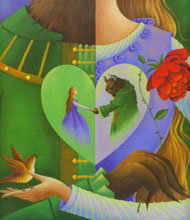Mirror Mirror: A Book of Reversible Verse by Marilyn Singer
Singer, M. (2010). Mirror mirror: A book of reversible poems (J. Masse, Illus.). Dutton Children's Books
Every story
has more than one side. We have been raised with fairy tales only hearing one
character’s perspective but what of the others? What was going through the prince’s
mind when he went to save Sleeping Beauty? What did Goldilocks think when she awoke
to three bears? Singer decides to explore these perspectives alongside the ones
we know through her unique and original reversible poetry. A short note about
this new form of poem is provided at the end of the book, though she does not share
why she chose to rewrite fairy tales. Each poem is written with careful
consideration for the form which allows it to be read and understood forwards
and backwards. To clarify, backwards means reading line by line going up rather
than down. To make this easier for the child reader, each pair of poems is written
side by side so that they can be read correctly and the subtle changes in
punctuation and intention can be identified. The form and word choice of each poem
is purposeful to allow it to make sense both ways. Because of this, each poem
is shaped differently to fit the words that need to be used.
The illustrations
only add to the purpose of this book: to use this new unique poetry style to
explore two sides of the same story. Each illustration takes up half a spread
letting the verses take up their own space on the other half. Symmetry is a big
theme in this book because of the design of the poems. This influences the
illustrations by making them balanced images that represent both perspectives
of each story. Each picture is split down the middle and either mirrored with a
different tone and coloring (the patterned image of the princess and the frog for
“Disappointment”) or displaying two separate images that bleed into each other
and connect (the split image of Jack climbing the beanstalk and a giant looking
down using clouds and the bright blue sky to connect the two for “Full of Beans”).
The medium of the art is not told to us, but the brightness of the colors
evokes the magical tone that typically accompanies fairy tales. The images themselves
also appear to be a mix of traditional and modern in style giving the
characters a more cartoonish feel that matches the tone of the poems.
Overall, this
book is a great for kids of different ages for different reasons. Young
children will be in awe of the illustrations and enjoy the new perspectives of
the stories they have heard many times. Older children will appreciate the
creativity of the reverso idea as well as the clever word choice that allows
each poem to have two meanings.



Comments
Post a Comment